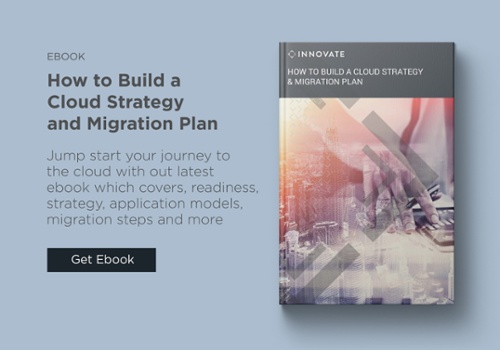
The cloud has become a core component of business technology strategy. Over recent years there has been a shift in the conversation around cloud adoption, and businesses are no longer just talking about the possibility of adoption but have already embraced cloud technology. The benefits of cloud computing can span your entire organisation.
The cloud is transforming how enterprises consume IT today by offering consumption-based resources and services that can scale up or down, as needed. This is a significant and very appealing benefit for SME as they can take advantage of a scale that was previously prohibited by cost.
If you need help understanding what you need to do to get started with a cloud strategy and migration plan then download our ebook How to Build A Cloud Strategy and Migration Plan
Competitiveness
Business agility is about whether a business can deliver products and services and launch new ones as and when required. This agility is essential for growing a business, and the cloud provides many benefits to support this.
The cloud can help you react to market conditions quicker, move into new markets easier, and start selling new products and services faster. The ability to take advantage of this flexibility when you need it will help your business gain market share.
Speed & Performance
If you are currently operating your IT infrastructure on an on-premises basis, you know that you are limited on speed and performance, as your current hardware can only perform up to a certain level. This can be very limiting for companies and prove expensive during periods where they will need more capacity or better performance. Capacity planning can be difficult, and to cater for these peaks in workloads, you may have to purchase higher spec hardware that may only be required to meet peaks in demand.
With the cloud, you can quickly increase processing power for specific periods of time when you need it. This provides great flexibility, as well as potential cost savings, with the added benefit of taking the pressure off those tasked with capacity planning.
Global Scale
The benefits of cloud computing services include the ability to scale elastically. In cloud terms, what this means is delivering the right amount of IT resources – for example, more or less computing power, storage, bandwidth – exactly when it is needed, and from the right geographic location. This is particularly important for businesses that are operating on a global scale.
Performance
The big cloud service providers like Microsoft or Amazon run on a global network of secure data centres, that are regularly upgraded to the latest generation of fast and efficient hardware. This offers several benefits over a single corporate data centre, including reduced network latency for applications and greater economies of scale.
Workplace Productivity
The on-site data centres typically require a lot of “racking and stacking” – hardware setup, software patching and other time-consuming IT administration tasks. Cloud computing removes the need for many of these tasks, so IT teams can spend time on achieving more critical business tasks.
In addition to this, collaboration and productivity are significantly improved across your entire organisation, across all departments by using cloud-based business solutions like Microsoft Office 365 for collaboration, communications, day-to-day operational tasks etc. In fact, moving as many software applications as you can to the cloud will enable true mobility. For example, if you are on a business trip and need to access financial accounts information quickly – if that software is in the cloud then it is no problem gaining access. As the need to be able to work anywhere increases, cloud has become essential rather than ‘nice to have’.
Reliability, DR and Business Continuity
Cloud computing makes data backup, disaster recovery and business continuity easier and less expensive because data can be mirrored at multiple redundant sites on the cloud provider’s network. No need to backup onto tape and have a storage company coming in every day to take the tapes off-site.
The days of spending time in your ‘DR Centre’ replicating backup of office systems from backup tapes, getting them up and running with end users on-site to test them is a thing of the past.
Application Development and Modernisation
If you’re in the software business using on-premises platforms, then this is not enabling you to adopt modern services. The cloud provides an integrated platform for modern development where development teams can increase speed and productivity.
Cost
The costs of buying, powering, cooling, managing and maintaining hardware in addition to the IT experts required to manage the infrastructure soon builds up. Businesses have realised that even solely for this reason, moving to the cloud can be a very attractive option, as cloud computing helps eliminate some or all of those capital expenses – depending on what model you decide to adopt.
Reducing IT Overheads and Risks
Transferring management of your core infrastructure to a cloud services provider is an excellent motivation for many companies. If you are a smaller business that doesn’t want the overheads of a big IT department then it is the perfect solution. If you move to a solid cloud provider, then you are also reducing risk.
So, if you are considering moving all or part of your business to the cloud then you are on the right track. It does not have to be an all or nothing solution – you can have the best of both worlds by mixing on-premises with the cloud. You can define a strategy to move over time which can be easier to manage.
However, before you do, the first step is knowing why you are doing it and setting goals for what you are trying to achieve. Then you need to start working on the details of your current IT infrastructure and application portfolio so that you can start putting together your strategy for each part.
If you need help understanding what you need to do to get started with a cloud strategy and migration plan, then download our ebook by clicking on the image below.




